The Witches are out
This week: The Witches are out; Start with a plan; Burning briars; The fog on the plain; Charge of the Heavy Brigade;
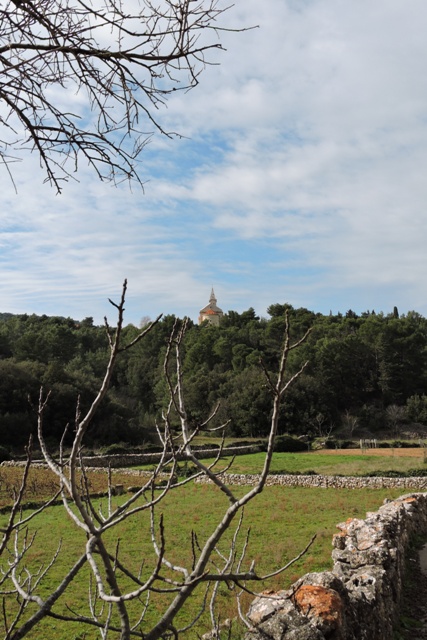
It’s Saturday once again. I don’t know where the weeks go to, but go they do…
We’ve just had our morning coffee break on the terrace in the warm spring sunshine.

Well I had the coffee and the Mačići had chew sticks. While I wait for the air to warm before I start work, I thought I would pen a few lines.
The cold weather has been and gone and we are back to more seasonal normal temperatures.
Last Sunday night was the coldest February night I have recorded since moving to Dol, but only just by 0.1 of a degree Celsius, at -2.4ºC. The previous record low for the 6th week of the year was in 2015 when I recorded -2.3ºC.
The big difference to this year’s cold snap has been the weeks leading up to it.
Back in 2015, there were two weeks before and after where the weekly nigh time lows were below zero Celsius. In 2021 the average low the week before was 12.1ºC. Because the cold we experienced was over a weekly data recording break, the average was 7.1ºC for last week and this week it has been 7.7ºC.

As soon as the sun comes out, the air temperature is quickly up into the mid teens.
The good news is that for the next week there will be sun and no cloud every day. Although this means cool nights, the days will be lovely for working outside.
The Witches are out
Of all the seasons of the year, living here in Dol I like the spring the best. Sunshine begins to stream through the windows, warming the house and the world outside.
Flower buds are swelling every where you look.
In a few days time, the plum trees will be covered in white confetti as the flowers open.

I have planted a number of fragrant flowering shrubs in various places around my home. Almost all of them are spring flowering varieties.
As I walked past the Hamamelis this week, I could smell the fragrance from the flowers. This was before I actually saw them. The common name for the genus is Witch Hazel.
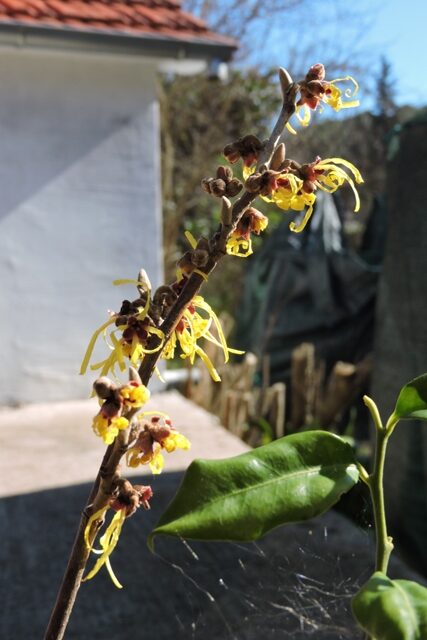
It has nothing to do with black magic, rather coming from the Middle English word “wiche”, meaning bendable or pliant.
I have two varieties growing, the yellow flowered Intermedia ‘Pallida’, and also the red flowered Intermedia ‘Diane’.

My Iris Reticulata v. “Harmony” have also come into bloom this week and yes, I need to do some weeding here too!
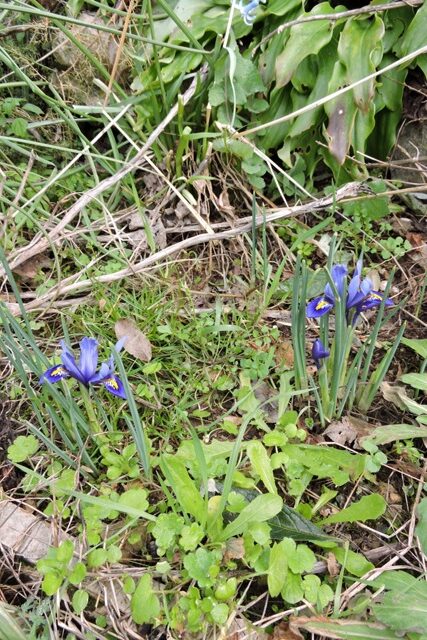
Start with a plan
The Mediterranean Spring is the time of year when everything bursts into growth. Now we are right in the middle of that growth spurt, the recent cold snap not withstanding.
On Sunday, when it was too cold with the wind chill to do anything useful outside, I wrapped up well and had a wander around to see what I need to do over the next couple of months.
Back inside in the warm study, I wrote out my “to do” list.
The cold winds have dried the ground nicely, so one of the immediate tasks is to start again on digging out the path behind the workshop.
I made a start last autumn, just before the first of the rains. Over the winter the soils have been too wet to do more.
I want to get the courtyard paved this year, and the pavers will run around the workshop. But before that can happen, I need to dig out the route and then I can get a quote for laying the stones.
The weeds are growing in the orchards and every where else too. On my walk round, I noticed in the Top Orchard that a lot of short grasses have grown between the trees.
There are patches of bramble briars which I didn’t clear last year. But going regularly into the olive groves with the felines, where these is grass under foot, it is rather nice.
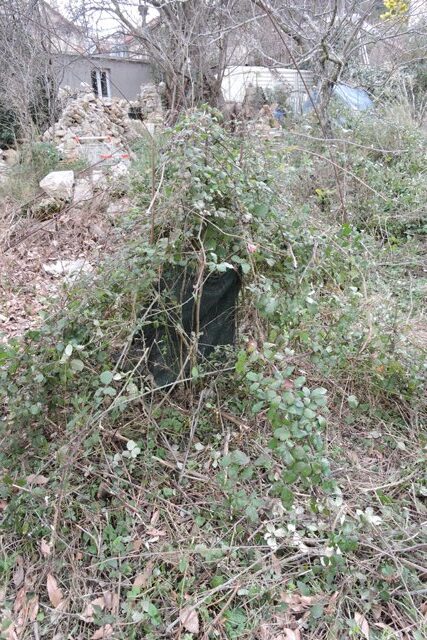
I have had pieces of cardboard down, and indeed still have some around some of the trees, as a weed suppressant. But mainly there is now a lot of short grass.
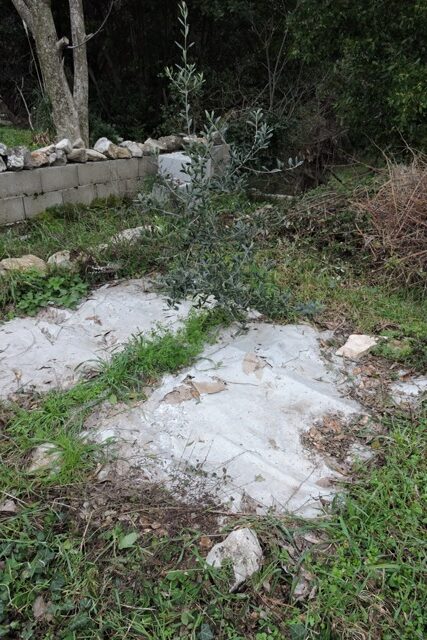
I also dug out a couple of old tree stumps which have been waiting for the soils to be dry enough to work.
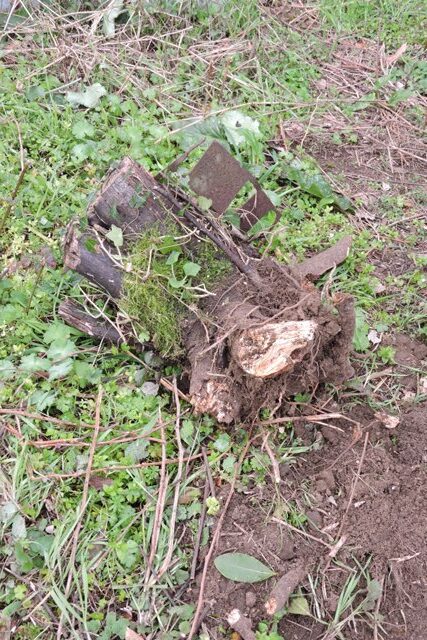
At the back of the garden shed I have a flymow that came with me from the UK.
It is definitely a product of the 1980’s. Powered by a small Kawasaki 2T engine, it is the ideal garden machine for rough grass. This is why I kept the flymo, when I sold my Ransomes cylinder mower.
When I moved overseas, I knew I would never again need a lawn mower capable of giving a bowling green finish to grass.
My plan is to regularly go over parts of the orchard, keeping big weeds down and trimming the grass. So it becomes an easy maintenance task.
As a hover mower, it takes small stones and rough ground in its stride.
Being at the back of the shed, it took a little manoeuvring to get it out into the daylight. With a few drops of lubricating oil and some 2T petrol mix, the engine spluttered into life on the third pull of the cord and then promptly died.
I did a quick check of the air filter as I suspected a carburettor problem. Inside there was a lot of debris, but the jet chamber seemed clear.

After a quick investigation, I think the carb needs to come off and have a thorough clean. This is something I don’t think I have ever done.
My Flymo has been one of those little machines which needed and has had little maintenance over the years, so some work is now long overdue.
Burning briars
I made the decision when I bought the property that I would plant the trees in the orchards and then get on with the building and restoration work.
Meanwhile the trees would establish themselves and need minimum maintenance.
My plan was then when the building work was finished, I could concentrate on the landscaping and other plantings.
Like all great plans it hasn’t quite worked out. I’ve planted most of the trees, however the building work is taking much longer than I anticipated. This is because of the difficulty in getting the required building permissions.
Last year, after having the workshop built, I rather neglected the orchards in favour of completing the inside of the new building. This year I need to spend a lot more time on ground’s maintenance work.
I started this week by using a brush cutter to trim down all the blackberry briars that have appeared.
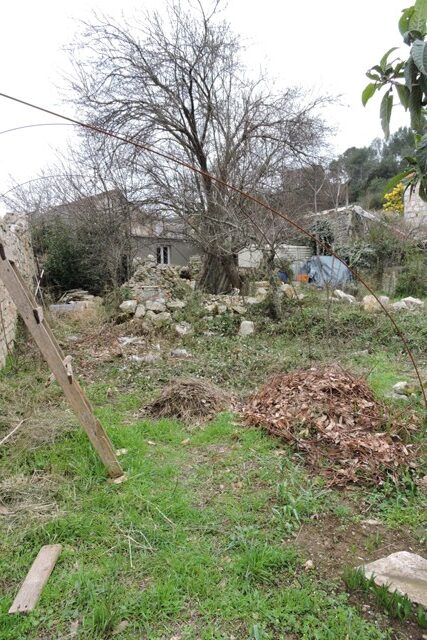
There were rather more brambles than I had noticed. However it was not a difficult task with a machine to cut the worst away, finally finishing close to walls and trees by hand.
I’m leaving the cut pieces on the ground for now so they dry out. I then have to make a decision about whether I will burn them, or put everything through the mulching machine.
The problem with briars are their thorns, which seem to penetrate even thick gloves.
The mulching machine would be the more environmentally friendly option – except is has a petrol engine. But a bonfire would quickly remove the detritus, and make some potash as well.
However as well as destroying the eggs of pests, a bonfire would also destroy any eggs and larvae of the beneficial insects that I have too.
Insect eggs, caterpillars and larvae are too small to see and I couldn’t identify friend from foe, even if I could see them. Then there are the chrysalis in the top layer of the soil which would be killed under any fire.
I have only had one bonfire in six years, so it is not as though it is an annual event.
I already have all the fruit tree prunings in a pile, waiting to be put through the mulching machine. Mainly these are without thorns (except the Pomegranate) so burning the briars may be the lesser of two evils.
The fog on the plain is all mine, all mine
As the days lengthen, by three minutes of daylight a day, so the natural world in Dol is waking from it’s winter torpor.
Butterflies are out and flying and I think that, fingers crossed, most blossom on my fruit trees will have survived last week’s cold blast.
Most mornings this week, the cold sink on Stari Grad plain has been clouded in fog. So while here in Dol, we are above the level and have enjoyed the warm sunshine, on the plain is has been cold and damp.

From my terrace, without leaves on the trees, as I look down on the clearly defined inversion layer, I’m reminded by the folk song by Lindisfarne about the fog being “all mine”.
The ground is drying up quite nicely in the spring sunshine, sufficiently to allow footfall without compressing the soils.
The charge of the Heavy Brigade
I brought out the big breaking hammer for the compacted soils in the old fold yard this week. This is where I want the all-weather path to run, around the workshop.
Although the soil is of good quality, because it has had a lot of treading, especially during last year’s building work, I couldn’t break it by hand with the pickaxe.
With a lot of sunshine forecast for next week, it is the ideal time to riddle the soil to remove the stones. I’d like to finally finish the path that I started to make back in late September.
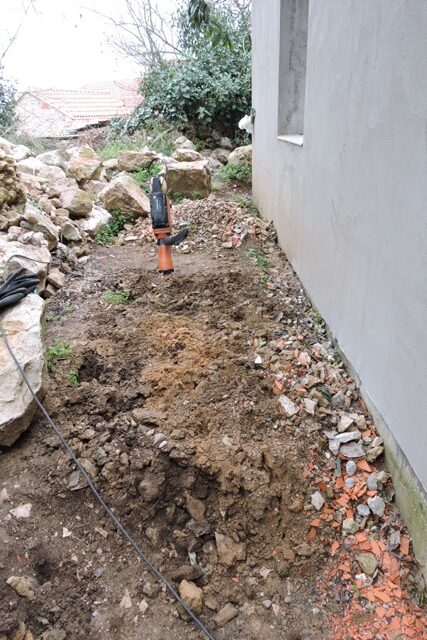
It was not a long job with the breaker to to take the soil back to where I will position the power riddle.
I’ve mentioned a couple of times over recent months that I have been given some standing firewood up on the hill behind my home. I just need to cut and remove it.
One tree in particular is a dead Italian Funerial Cypress, Cupressus sempirvirens ‘Stricta’,

These trees are a feature of the Mediterranean landscape and they can be seen all around Dol. There is one specimen close to my orchard and standing more than 25 meters tall.
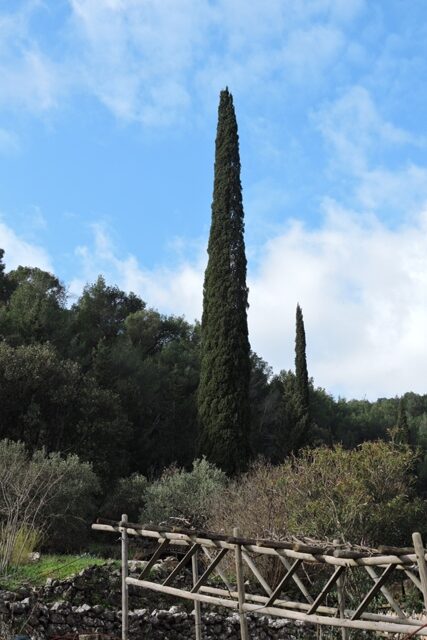
They are a majestic, architectural conifer and are a far cry from the dreaded Cupressus Leylandii. This statuesque conifer is a tall, narrow columnar evergreen. The tree has been cultivated since ancient times across the Mediterranean basin.
The dark green vertical spire shape of these trees is a highly characteristic signature of Mediterranean towns and villages. Their green spires can been seen throughout the Maquis on the hillsides above Dol.
My neighbour called this week to say he would help me cut it down.
Measuring 45 cm across the bowl of the tree, there are a huge number of growth rings visible. Far too many to count without the assistance of a strong magnifier.

It has been dead for some time, although there is no evidence of disease in the tree.
However, once cut the boring insects have been hard at work, with their tunnels visible in every cut. A vast network uf runs under the bark was also visible.
Whether this insect infestation was the cause of the tree’s death, or happened because of it, I don’t know.
It was no more than an hour’s work to reduce the tree to 30 cm lengths. These are just the right size for my stove.
The side branches have been left in a pile for insects and animals to colonise.
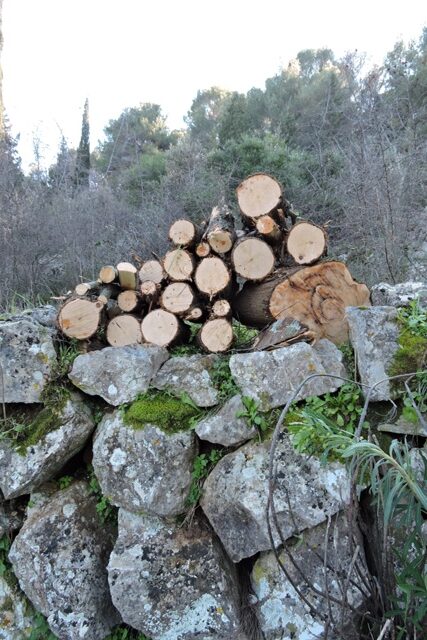
I brought this wheelbarrow load of wood home. It was mostly cut from the top three meters of the tree, whilst the rest has been neatly piled on the hillside.
I’ll remove it later. NCG